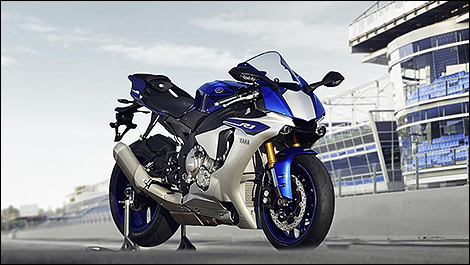Yamaha continues superbike warfare with the all-new 2015 YZF-R1, which produces 200 hp and weighs just 199 kg (179 kg dry weight). Using MotoGP's 2014 M1 as inspiration, it makes a strong case for being the No.1 road-going missile along with the 200-hp BMW S1000RR and 201-hp Aprilia RSV4 RR.
Sporting a thoroughly revised and improved version of Yamaha's 4-cylinder engine with cross-plane crankshaft, the juiced-up R1 shows like no other the Japanese manufacturer's leadership on the innovation front while putting an end to rumours of a 3-cylinder engine.
 |
| Photo: Yamaha |
Some engineers deserve a raise
Larger valves, high-tech "Finger Follower" rocker arms, a higher-capacity air box, titanium "fracture split" connecting rods, and an offset cylinder design (for reduced friction) all contribute to the 2015 Yamaha YZF-R1's increased power. A new, single-axis balancer shaft is used to reduce engine vibration.
The redesigned, more compact transmission features optimized gear ratios and a new, multi-plate slipper and assist clutch assembly. The stacked gearbox/clutch layout centralizes mass and keeps overall engine size shorter front to rear. What's more, a new exhaust valve device features two separate exhaust flow routes depending on rpm. This allowed engineers to build a compact muffler that achieves both outstanding power and torque characteristics while still providing sufficient silencing performance.
Race-inspired styling
The 2015 Yamaha YZF-R1 is styled after the multi-time world champion with a new, eye-catching front fairing that clearly shows where the race number would go, a new, compact 4-2-1 exhaust system, and a very small frame with an upswept tail. The resemblance between the production R1 and the race-spec M1 is striking.
Thanks to titanium header pipes and muffler, a magnesium cast rear subframe, magnesium wheels, a 520-series drive chain, as well as a lightweight battery and fuel tank, the 2015 YZF-R1 lost 8.1 kg. It uses an all-new, gravity cast aluminum Deltabox frame (which is left-right asymmetrical for reduced weight and size) with an aluminum upward truss-type swingarm.
Engineers say the
2015 Yamaha YZF-R1 is more nimble than its predecessor and provides better tire feedback courtesy of revised geometry and new KYB suspension components. As for the brakes, look for stainless steel brake lines and Yamaha's Unified Braking System (UBS) featuring its latest anti-lock brake (ABS) technology.
Yamaha Ride Control
After several years of development and testing in MotoGP and AMA racing, Yamaha finally endowed the YZF-R1 with the latest electronic aids available -- and called it “Yamaha Ride Control” (YRC). The traction control system with lean angle sensor features nine settings plus off for a total of 10 settings, while four engine maps are at the rider's disposal. Slide control, lift control, launch control, and a quick-shift system are also part of the package.
The Inertial Measurement Unit (IMU) features six axes of measurement using a gyro sensor to detect rotational motion in the pitch, roll and yaw directions. A "G" sensor detects acceleration/velocity in the forward & back, up & down and left & right directions. The vehicle position information obtained from the two sensors including bank angle, pitch rate and sideways slide acceleration is sent to the ECU which in turn controls the aforementioned riding aids.
Innovation on the new 2015 Yamaha YZF-R1 continues with a fully digital instrument panel featuring a TFT liquid crystal display. Two modes are available: Street offers all the usual info, while Track displays a bar-style tachometer (starting at 8,000 rpm), lap number, lap timer, stop watch, gear position indicator, and YRC setting info.
Still not satisfied? Check this out...
Track-day enthusiasts and race teams will be thrilled with the new 2015 Yamaha YZF-R1M, which adds a premium, electronically controlled Ohlins race suspension, a lightweight carbon fibre bodywork, and the brand's new Communication Control Unit that is both a data logger and data setting tool. There's also a wider, 200-series rear tire, as well as a polished and clear-coated aluminum fuel tank and swingarm.
This is Yamaha's vision: to build a superbike with MotoGP technology that even mere mortals can enjoy riding. The YZF-R1M, in particular, rises to the level of FIM Superstock 1000 racing. It becomes the most powerful and advanced Japanese superbike on the market.

